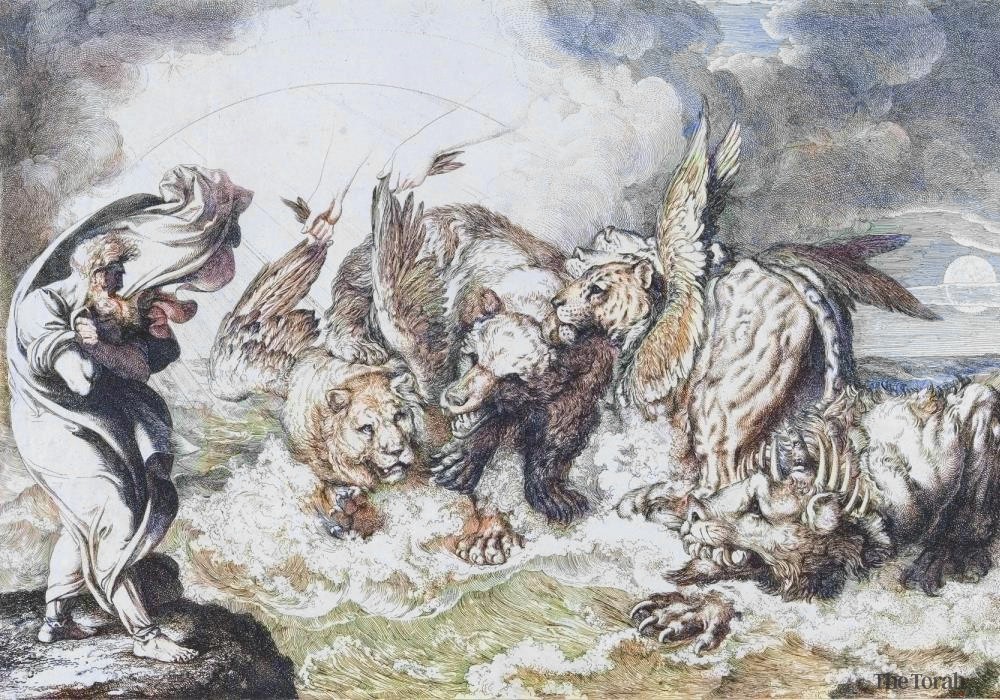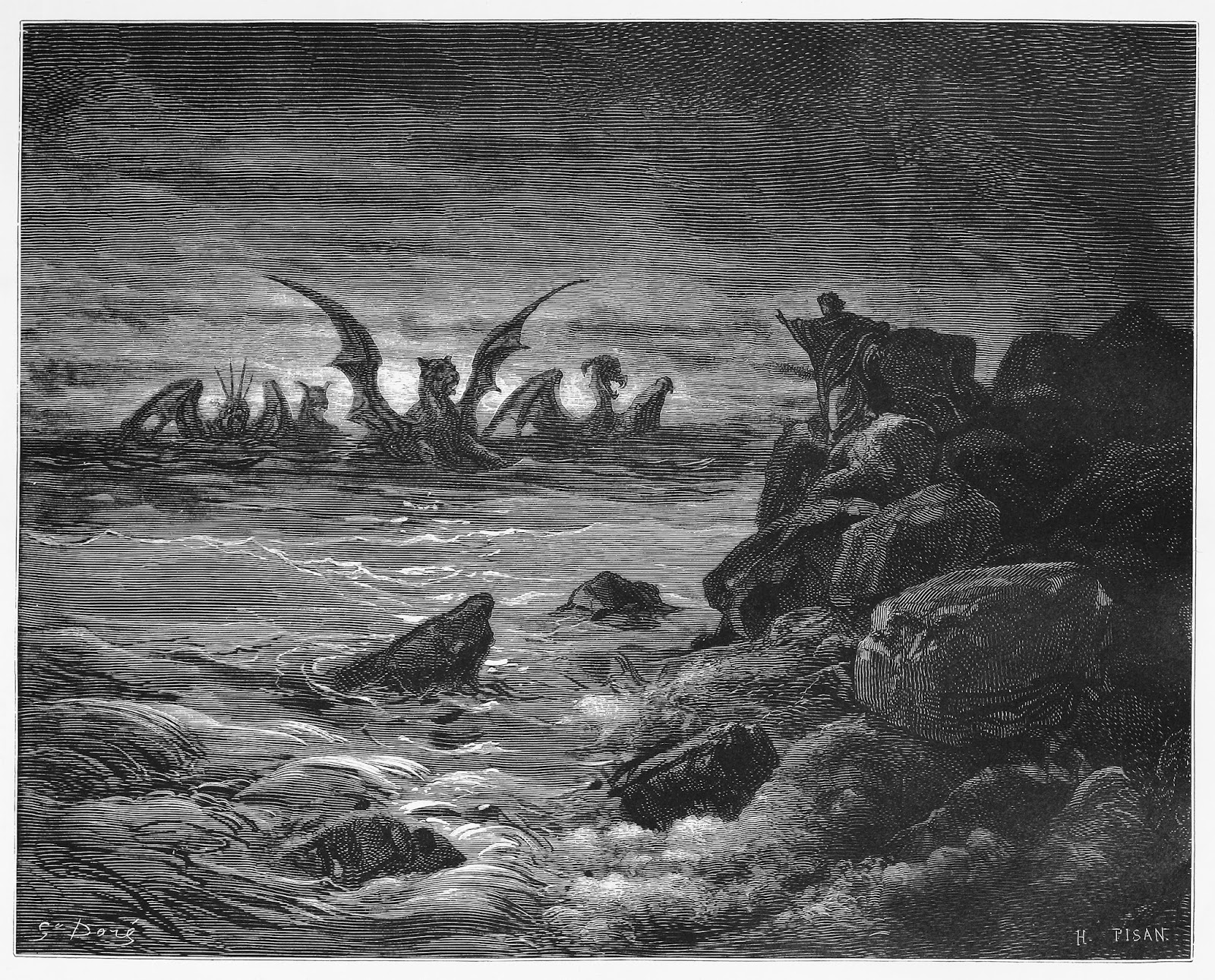Daniel 7:9-15

Dan.7:9 I beheld till the thrones were cast down, and the Ancient of days did sit, whose garment was white as snow, and the hair of his head like the pure wool: his throne was like the fiery flame, and his wheels as burning fire.
10 A fiery stream issued and came forth from before him: thousand thousands ministered unto him, and ten thousand times ten thousand stood before him: the judgment was set, and the books were opened.
11 I beheld then because of the voice of the great words which the horn spake: I beheld even till the beast was slain, and his body destroyed, and given to the burning flame.
12 As concerning the rest of the beasts, they had their dominion taken away: yet their lives were prolonged for a season and time.
13 I saw in the night visions, and, behold, one like the Son of man came with the clouds of heaven, and came to the Ancient of days, and they brought him near before him.
14 And there was given him dominion, and glory, and a kingdom, that all people, nations, and languages, should serve him: his dominion is an everlasting dominion, which shall not pass away, and his kingdom that which shall not be destroyed.
15 I Daniel was grieved in my spirit in the midst of my body, and the visions of my head troubled me.
If you saw the picture and came thinking we are studying the 4 beasts here, I apologize. I only used the picture because I liked it. Although he does mention the beasts in v11-2. So, I’ll just throw this out here that they are not the same kingdoms as Daniel 2 in Nebuchadnezzar’s dream since they are present when Christ returns. Another problem with making them the same is verse 1 “In the first year of Belshazzar king of Babylon”, Daniel has the vision after which “four great beasts came up from the sea” v3. Along with v17 “These great beasts, which are four, are four kings, which shall arise out of the earth.” Indicating they arise after Babylon thus cannot be Babylon.

But to our study of 7:9-15 ...
The first thing about the passage we must note is that this is received by Daniel in night visions which is a dream. (Job 33:15, Isa.29:7) The reason we note this is to indicate that an interpretation is required as dreams are by design not perspicuous (Num.12:6-8). The next thing to consider is that Daniels revelation was not to be understood until the revelation of Jesus when knowledge shall be increased. (Dan.12:4, Rev.22:10) Therefore, the New Testament must interpret the passage. We do not use this passage as a template to organize other passages, but we organize this vision by New Testament revelation.
As this is the case, we realize that his visions are a combination that are not chronological in each detail. For example, when it states in v13 “one like the Son of man came with the clouds of heaven” it would be understood as coming from heaven to earth when evaluated in the New Testament. This is how Jesus interpreted the passage in Matt.26:64 (as Mk.14:62). “Jesus saith unto him, Thou hast said: nevertheless I say unto you, Hereafter shall ye see the Son of man sitting on the right hand of power, and coming in the clouds of heaven.” 24:30 “And then shall appear the sign of the Son of man in heaven: and then shall all the tribes of the earth mourn, and they shall see the Son of man coming in the clouds of heaven with power and great glory.” Again in Rev.1:7 “Behold, he cometh with clouds; and every eye shall see him, and they also which pierced him: and all kindreds of the earth shall wail because of him. Even so, Amen.”
Thus, to interpret the passage of his coming in the clouds as Christ’s ascension into heaven (in contrast to Jesus’ interpretation) will result in confusion (as post or a-millennialism). So, “and came to the Ancient of days” does not mean here ‘THEN came to the Ancient of days’ chronologically but ‘in addition’ or ‘also’. The “and came to the Ancient of days, and they brought him near before him” would be interpreted in Revelation 5:1-7 as pre-70th week of Daniel 9 when this same Son of man opens the seals and seals up the vision and prophecy.
Likewise, will the judgment being set and the beasts lives prolonged not make sense until you see this as a millennial reign on the earth (Dan7:14, 27). The beast being slain in v11, 26 matches Rev.19:20, premillennial- Rv.20:10. The other beasts lives prolonged would indicate they go alive into the reign of the Son of God upon the throne of David, fulfilling Psalm 2:8-12, Rev.20:1-6, Zech.14:16-19, Isa.2:1-4, 11:4-10, Isa.60.
This will have v9-10 as the gathering of the nations and the 1st resurrection. So, v14 fits with v9-10 and elaborates on Dan.2:44. Consider Matt.25:31-2 “When the Son of man shall come in his glory, and all the holy angels with him, then shall he sit upon the throne of his glory: And before him shall be gathered all nations: and he shall separate them one from another, as a shepherd divideth his sheep from the goats”. The resurrected saints live and reign with Christ over the nations for the millennium. (Rev.20:4-6, 2:26-7, Dan.7:27,14)
Because all judgment is given to the Son (Jn.5:22,27, Ac.17:31, Rom.2:16), we see him sitting as the Ancient of days (v9) in the glory of the Father. (Jn.17:5, Rev.1:13-17, Mt.16:27, 25:31, Mk.8:38, Lk.9:26) A foreshadowing of Rev.21:23 “the glory of God did lighten it, and the Lamb is the light thereof”.
Now, to those who think we are cutting and splicing arbitrarily here, consider another prophetic utterance in Psalms. (And gaps here.) We can see the New Testament rightly dividing Psalm 69, which contains explicit references to Christ while also containing references explicitly not to Christ. Note v4-5 “They that hate me without a cause are more than the hairs of mine head: they that would destroy me, being mine enemies wrongfully, are mighty: then I restored that which I took not away. O God, thou knowest my foolishness; and my sins are not hid from thee.” Verse 4 is quoted by Christ in John 15:25 as a reference to Himself. However, verse 5 cannot be a reference to Christ as he “did no sin”, was “without sin”, and “cannot sin”. (1 Pt.2:22, Heb.4:15, 1 Jn.3:9) Psa.69 continues with multiple references to Jesus. Verse 9a is quoted in Jn.2:17 and 9b is quoted in Rom.15:3 both referencing Jesus. Likewise verse 21 is quoted in Mt.27:34. We see this division applied in 2 Sam.7:13-4 where Christ is referenced followed by Solomon being indicated. “He shall build an house for my name, and I will stablish the throne of his kingdom for ever. I will be his father, and he shall be my son. If he commit iniquity, I will chasten him with the rod of men, and with the stripes of the children of men”. Where the LORD says “I will be his father, and he shall be my son” we see this quoted in Heb.1:5 speaking of Jesus again. But the latter part of v14 is not Christ for the same reason as the Psalm.
What think ye?
No comments:
Post a Comment